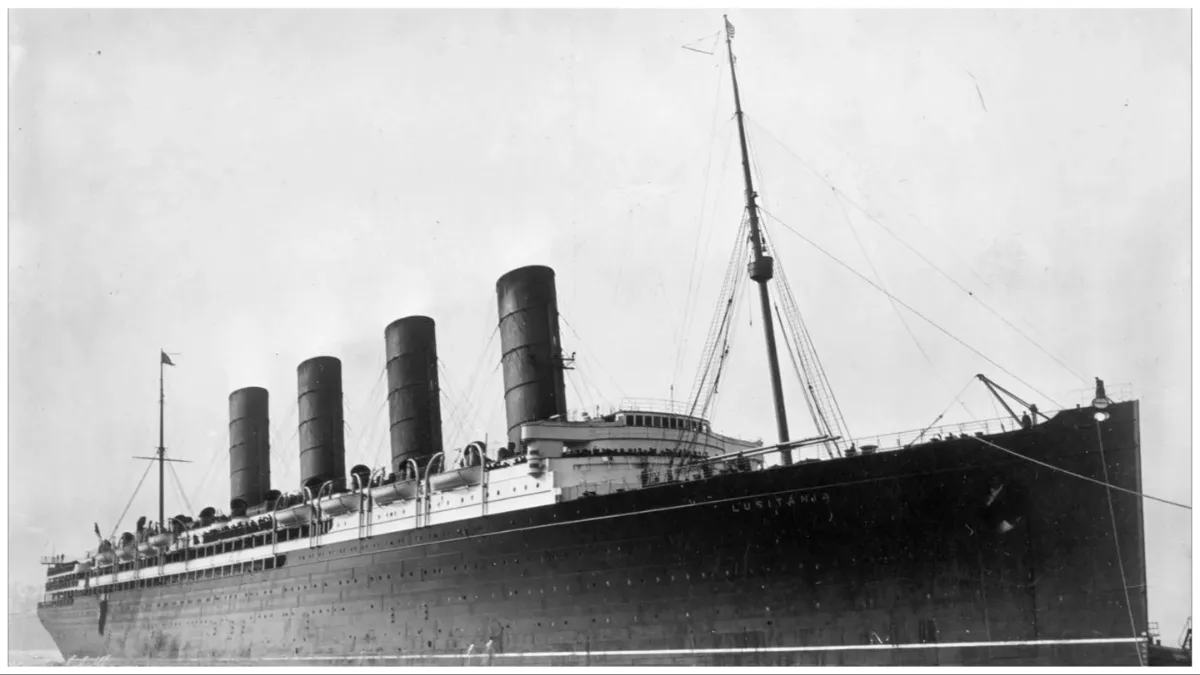You may not know alot about the story of the Lusitania, but you are probably familiar with the events it set in motion, namely, a broader World War I. This commercial passenger boat and 1,198 of its 1,959 passengers, including 128 Americans, all died in the Atlantic ocean after it was torpedoed by a German U-boat off the Irish coast on May, 7, 1915. Here’s the story of how that happened.
World War I was the bloodiest and most violent conflict in human history up to that point. An estimated 16 to 20 million people lost their lives, including between 6 and 10 million civilians. The combination of entrenched front lines, modern weapons like the machine gun, stalemates, and the dangers of disease made it an absolute hell to experience. Up to that point, America had more of an isolationist policy, but the sinking of the Lusitania is cited as one of the reasons that changed, and the U.S. entered the war.
The Largest Ship in the World
The Lusitania was an ocean liner owned by the Cunard Line, a company that was a leader in transatlantic travel at the time. The company started production on the ship in 1904 and it had its maiden voyage in 1907. It was the biggest ship in the world at the time, measuring 787 feet (almost 3 football fields) long and weighing over 31,000 tons. While it was a luxurious vessel, the Lusitania captured everyone’s attention due to its high speed. The vessel could travel 24 knots (28 miles an hour), an unheard-of speed at the time.
The ship mostly traveled the transatlantic route, a shipping passage that crosses the Atlantic and connects Eastern North America to Europe. The ship itself mostly traveled between New York and London, and in addition to passengers, it hauled cargo and mail between the two cities. Unfortunately, the disaster following the German attack is what this historic ship will mostly be remembered for, despite its capabilities.
The political climate before Lusitania was torpedoed by the Germans
In 1914, Archduke Franz Ferdinand of Austria-Hungary was assassinated, a spark that would ignite into the fire of the First World War. At the time, Europe was split into two sections, each with their own alliances. One alliance was called the Triple Entente, which means “triple agreement” or “understanding” in French. That bloc included France, England and Russia. On the other side there was Austria-Hungary, Italy, and Germany.
After the assassination, Austria-Hungary declared war on Serbia, and Germany honored its alliance with Austria-Hungary, and followed suit. As tensions in the area flared, Germany developed the Schlieffen Plan. This military strategy was created so that Germany could quickly defeat France in case a two-front war broke out with France and Russia. As things continued to heat up, Germany enacted the plan and invaded Luxembourg and Belgium to get past French defenses along the border. When Germany invaded neutral Belgium, Britain declared war on Germany on August 4, 1914.
When England joined the war, so did the rest of its empire, which at the time included India, Australia, and Canada. As more countries joined and stayed true to their alliances, most of the countries in the world were now involved. Germany declared various areas on the ocean as war zones, including the transatlantic route. In the North Sea, Germany wanted to stop trade and much needed war supplies to Britain.
The Germans also targeted the allies in the Mediterranean Sea and the wider Atlantic Ocean. The Lusitania had to travel through the Irish Sea, which the Germans also designated as off limits.
Unheeded Warnings by the Lusitania’s Captain
There were a number of merchant ships sunk by German U-boats in 1916, and with reports of heightened submarine activity in the area, the British Navy warned Lusitania’s captain, stressing that the boat should proceed with extreme caution. They told the Lusitania to implement evasive techniques, like zigzagging and changing course randomly every few minutes, to confuse nearby U-Boats.
Captain William Thomas Turner ignored these warnings, but it wasn’t out of obstinance. The reports coming in conflicted with each other, which may have led the captain to think the threat wasn’t as great as it actually was. Also, the boat was fast and had the capability of outrunning most submarines. The Lusitania was also part of a convoy, which perhaps gave the captain a false sense of security. Then he had the passengers to think about; he didn’t want to cause undue stress or panic among the paying travelers.
Regardless, he ignored the warnings, and continued on with business as usual. This turned out to be a deadly mistake.
The sinking of the Lusitania
The Germans opened fire on the Lusitania on the afternoon of May 7. The torpedo hit on the ship’s midsection on the starboard side and shortly after that, a second, bigger explosion happened, possibly due to damage to the engine’s steam engines and pipe system. Also, the Lusitania was unfortunately carrying a large amount of ammunition onboard. Between rifle ammunition and shells, there were about 173 tons of explosive material on board. The ship took about 20 minutes to sink and 1,198 people died, including 128 Americans; 761 people survived.
Because Germany had put out warnings about the zones it was protecting, it didn’t feel like it did anything wrong in attacking the ship. Germany said there were two main issues at play: The vulnerable U-Boats were on the surface, and a previous announcement from the British government that it was going to install weapons on merchant ships. About a week after the the attack, on May 15, the U.S. sent a note to Germany about how it disapproved of how Germany was using its submarines, written by then President Woodrow Wilson and Secretary of State William Jennings Bryan.
The note said that the U.S. was shocked by the action because “German views and the German influence in the field of international obligation as always engaged upon the side of justice and humanity” and that “[The] Government of the United States was loath to believe — it cannot now bring itself to believe — that these acts, so absolutely contrary to the rules, the practices, and the spirit of modern warfare, could have the countenance or sanction of that great Government.”
The United States, which was clinging to a national policy of neutrality, wouldn’t enter the war for another two years, but the sinking of the Lusitania is considered one of the main factors for eventually doing so.







